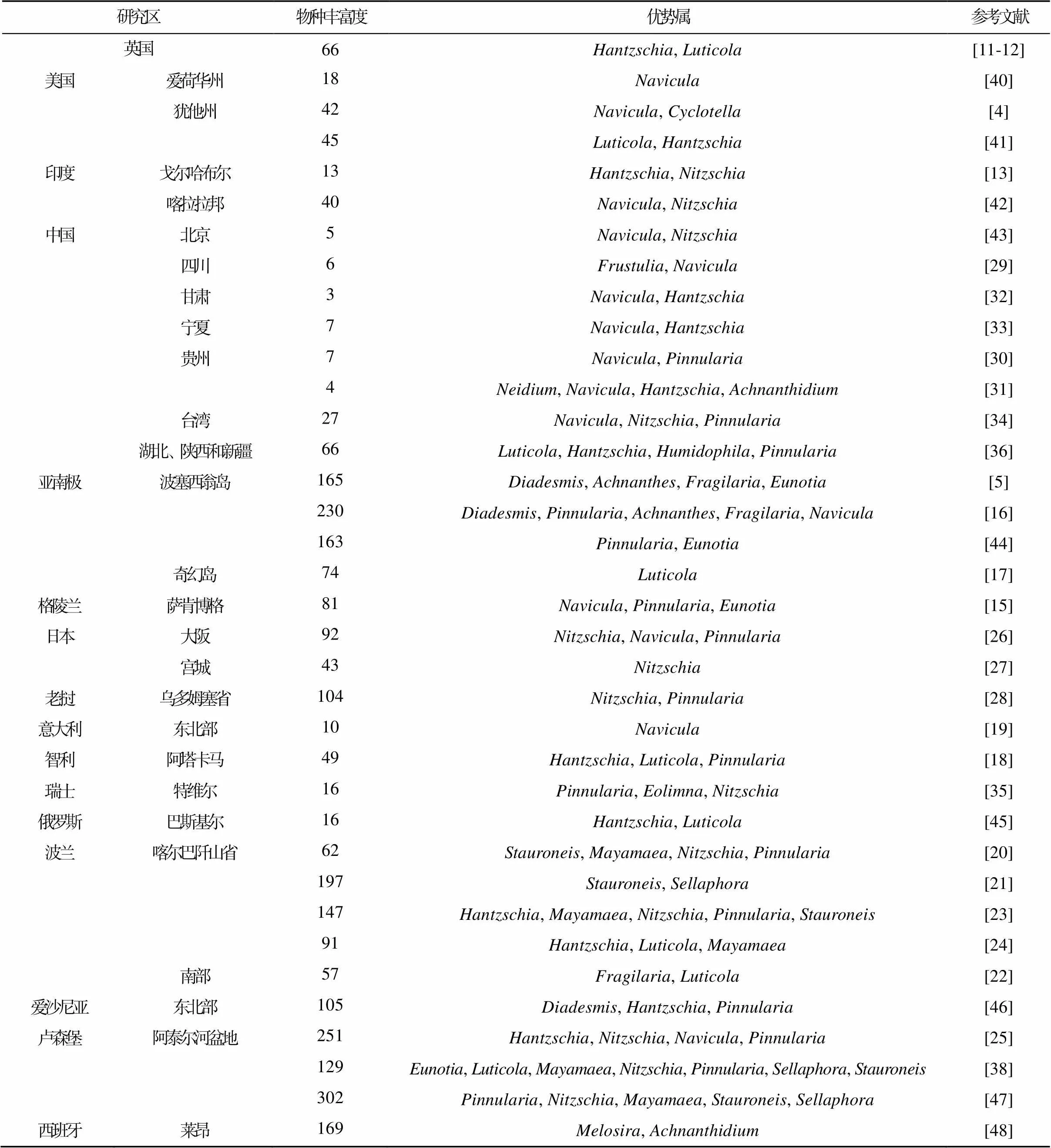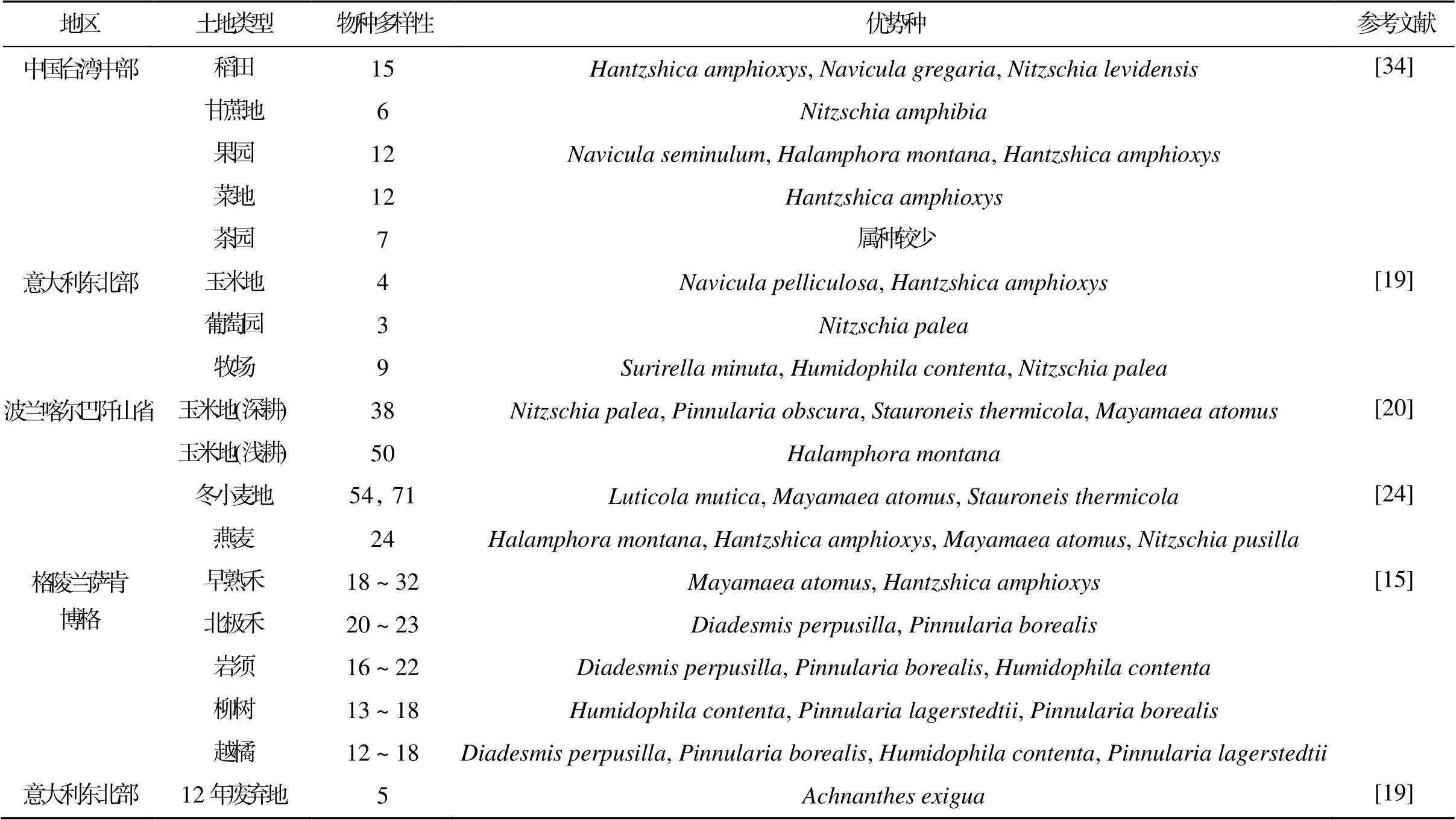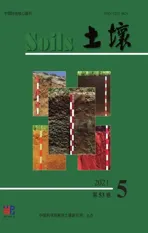土壤硅藻研究进展①
2021-11-17张玉克
张玉克,陈 旭
土壤硅藻研究进展①
张玉克1,2,陈 旭1*
(1 中国地质大学(武汉)地理与信息工程学院,武汉 430078;2 武汉大学资源与环境科学学院,武汉 430079)
硅藻是水环境监测最常用的生物指标之一,相比而言,陆生硅藻的研究相对较少。硅藻作为土壤微生物的重要组成部分,在土壤生物地球化学循环中起到重要的作用。土壤硅藻的研究历史可分为:起步时期(20世纪10年代至50年代)、缓慢发展时期(20世纪70年代至90年代)和快速发展时期(21世纪初至今)。本文重点对土壤硅藻的生物多样性、地理分布特征及其生态环境指示意义进行了总结。目前文献中报道的土壤硅藻属种已超过300种,其中亚南极、波兰及卢森堡的硅藻物种多样性相对较高,土壤中发现的硅藻大致可以分为嗜酸、嗜碱和普适种3种类型。已有的研究发现硅藻对土壤的酸碱度、湿度、有机质含量等环境因子变化响应敏感,是潜在的有效生物指标。在建立土壤硅藻标准分析方法基础上,未来还需要加强土壤硅藻分类学、不同类型土壤间硅藻对比分析和全球土壤硅藻生物地理学研究,此外,还需关注硅藻在土壤生物地球化学循环中的作用。
土壤硅藻;生物多样性;环境指示;地理分布
硅藻是一类具有硅质壳体的单细胞自养型藻类,其种类繁多、数量庞大,全球物种丰富度在(3~10)× 104[1]。目前绝大多数硅藻研究聚焦于水生生境,硅藻作为浮游食物链的重要组成部分,也是地球上重要的初级生产者,在全球生物地球化学循环中发挥着重要作用,其光合作用每年可贡献约20% 的全球初级生产力,因而硅藻在全球碳循环中的作用可以与陆地雨林相媲美[1-2]。同时,硅藻因对水环境变化响应敏感且易于鉴定和保存,而被广泛应用于水环境监测与评价[3]。除了水生生境,越来越多的研究发现硅藻还广泛分布于沙漠[4]、土壤[5]、洞穴[6]等陆生生境。
在土壤生态系统中,硅藻作为微生物中的重要组成部分,参与土壤中碳硅等生源元素的生物地球化学循环[7]。但是,由于土壤硅藻研究历史相对较短,而且在样品处理和鉴定分析上存在一定困难,土壤硅藻的研究明显滞后于水生硅藻。尽管如此,近年来土壤硅藻研究呈现快速增长的态势。为此,本文尝试对国内外土壤硅藻研究进展进行梳理,总结不同地区土壤硅藻的物种多样性、生态环境指示意义等,并对未来土壤硅藻研究需要关注的方向提出展望。
1 土壤硅藻的研究历史
土壤硅藻的研究历史可大致划分为以下3个阶段:
1)起步时期(20世纪10年代至50年代):Petersen[8-10]最早于20世纪初对丹麦与格陵兰的土壤藻类进行调查,发现土壤中有硅藻生长。而后,Lund[11-12]于1945年和1946年在《New Phytologist》杂志上报道了英国土壤硅藻的组成,并探讨其与环境因子的关系。1956年,Gandhi[13]在印度西部的土壤样品中发现了13种硅藻,这是亚洲地区首次报道土壤硅藻。这一时期土壤硅藻研究虽然较少,但这些探索性工作为土壤硅藻研究后续发展奠定了基础。
2)缓慢发展时期(20世纪70年代至90年代):自20世纪70年代起,关于土壤硅藻的相关研究开始增加,而且研究区域范围也有所扩大。1986年,Schuttler和Weaver[4]首次报道荒漠地区的表土硅藻组成。20世纪90年代中后期,比利时学者在极地地区率先开展了土壤硅藻研究,发现极端寒冷的表土环境中存在较高的硅藻物种丰富度[5]。这一时期极端气候环境中的土壤硅藻引起硅藻学家的关注。与此同时,我国学者开始关注硅藻在土壤污染监测中的应用[14]。
3)快速发展时期(21世纪初至今):2000年以来,土壤硅藻的相关研究日益增加,随着土壤硅藻采样分析方法和分类系统的进一步完善,全球土壤硅藻的研究区范围不断扩大,而且发表文献数量也不断增加。研究区拓展至极地[15-17]、智利[18]、意大利[19]、波兰[20-24]、卢森堡[25]等国家或地区。在此期间,日本学者在东亚地区调查了水稻田硅藻组成[26-28],我国学者也相继报道四川[29]、贵州[20-31]、甘肃[32]、宁夏[33]、台湾[34]等地的土壤硅藻。这一时期土壤硅藻研究不局限于分类学研究,更加关注硅藻在土壤环境监测中的应用。一方面探索了硅藻对土壤环境因子的指示意义[35-36];另一方面,聚焦于硅藻在土壤生物地球化学循环中的作用,尤其是在硅循环中的作用[37]。此外,土壤硅藻采样分析方法也日趋成熟[38]:表层土壤采集通常采用五点法(在正方形采样区的四个角以及中心采集土样)或等距采样法(在长条形的采样区等距离采集土样)。在实验室预处理过程中,水体硅藻样品可直接加酸和氧化剂处理[39],然而,土壤硅藻在预处理前还需要经滤网过滤粗颗粒碎屑,并用蒸馏水搅拌振荡,取上层悬浊液(含硅藻)加酸和氧化剂处理。在条件允许的情况下,样品预处理后可采用重液浮选的方法进行浓缩,最后再进行硅藻制片与鉴定统计。
2 土壤硅藻研究的主要进展
2.1 土壤硅藻物种多样性
硅藻广泛分布于海洋、河流、湖泊、土壤等各种生境,据估计全球硅藻丰富度在(3~10)× 104,然而目前被记录的硅藻种类大约只有1万多种,因而硅藻分类学研究仍具有巨大的发展空间[1]。
16个国家或地区的土壤硅藻调查结果(表1)综合对比发现,这些地区的土壤硅藻物种数主要介于5 ~ 300,这表明土壤生境中硅藻物种丰富度并不低。在亚南极地区[5, 16-17, 44]、波兰[20-24]以及卢森堡[25, 38, 47]的长期调查发现,这3个国家或地区的土壤硅藻物种数均在200左右。在亚洲地区,仅有印度[42]、中国[43]、日本[26]、老挝[28]有土壤硅藻的相关报道,其中老挝与日本的水稻土中发现超过90种硅藻[26, 28]。这主要由于水稻田间歇式淹水环境,可以满足适应陆生和水生两种生境的硅藻同时生长。目前,我国报道的土壤硅藻属种数不超过70种,与上述5个地区的调查结果相比明显偏少,这主要由于目前国内土壤硅藻的研究偏少且主要聚焦于旱地类型[29-33,36]。这意味着在我国以及其他研究程度较低的地区,土壤硅藻物种丰富度可能由于研究深度不够而被低估。
此外,不同土地利用类型下的硅藻物种多样性及优势种均存在差异(表2)。即使作物相同,耕作方式的差异或种植区域的不同也会改变硅藻组成。在同一地区下,硅藻物种多样性随着土壤耕作强度减弱而升高。
2.2 土壤硅藻生物地理分布格局
不同地区的土壤类型各异,其土壤环境因子亦有所不同,这直接决定了硅藻组成上的差异。基于目前已有的全球不同地区土壤硅藻报道,总体上看,土壤硅藻优势属以耐旱类型为主,其中包括、、等,这些优势属广泛分布于全球不同区域下的土壤中,但不同地区的土壤硅藻属种组成略有差异(表1)。

表1 全球不同国家或地区土壤硅藻研究对比
根据硅藻的生态属性,可以将土壤中的硅藻大致分为3类(表3):①嗜碱性属种,主要以属为主,包括、和等属种,这些属种主要出现在偏碱性的土壤中;②嗜酸性属种,主要以属为主,包含、和等属种,其主要生存于较为湿润的酸性土壤中;③可适应不同土壤环境的普适种,和在土壤中广泛分布,在极度干旱的沙漠地区与季节性淹水的水稻土中均有报道。

表2 不同土地利用类型下的硅藻物种多样性及优势种

表3 土壤硅藻优势种及其生态属性
水稻土由于季节性淹水,属于水–陆过渡的环境,因而与其他类型土壤存在明显的差异。稻田中的硅藻在淹水期主要以、、属为主,而排水期主要以耐旱的、属为主[26-28, 53]。水稻土中的硅藻物种多样性明显高于其他类型农田[34]。
2.3 硅藻在土壤环境监测中的应用
硅藻对外界环境变化具有敏感响应,如在水体中,硅藻组合响应于酸碱度、光照、营养物质等[54],因而被广泛应用于水环境监测中。Falciatore等[55]指出硅藻对环境变化具有独特的响应策略,从而可以通过硅藻来评估水环境变化。尽管目前土壤硅藻与环境因子关系的调查相对较少,但已有的研究表明硅藻在土壤环境监测方面具有重大潜力。
在土壤等较为干旱的陆生生境中,湿度条件往往是制约硅藻分布的关键环境因子[54],硅藻组合大多以耐旱属种为主,这些属种通常能够耐受间歇式干旱条件,并通过分泌外包物(包覆物)实现自我保护[56]。除了水分条件,土壤酸碱度、盐基离子含量、有机质含量等环境因子也会影响硅藻生长与分布(表4),例如van de Vijver 和Beyens[5]发现亚南极地区波塞西翁岛的土壤硅藻分布与含水量、酸碱度及盐基离子含量相关,在湿润酸性环境中以为主,而在湿润弱碱性生境中与更为常见;Stanek-Tarkowska等[24]发现波兰土壤硅藻分布与土地耕作类型、含水量、酸碱度与有机质含量等相关;Lin等[34]发现含水量和酸碱度是影响土壤藻类组成的重要环境因子。此外,在重金属污染的土壤中,硅藻的生长会受到抑制。例如,钴、铜、锌等重金属污染的土壤中硅藻丰度明显减少[57]。而在季节性淹水的水稻土中,气候、灌溉–排水期、灌溉水源是影响硅藻分布的主要环境因子,如季风区的水稻土硅藻物种多样性高于非季风区,而以溪流、水库分别作为灌溉水源的水稻土硅藻组成及密度差异明显[26-27, 42]。因此,深入调查土壤硅藻与环境因子之间的关系,将有助于挖掘不同土壤生境的硅藻指示性属种,推进硅藻在土壤环境监测中的应用。

表4 影响土壤硅藻分布的主要环境因子
3 研究展望
土壤硅藻研究目前正处于快速发展阶段,未来还需要注意加强以下几个方面的研究,以推动土壤硅藻研究的进一步发展。
3.1 加强土壤硅藻分类学研究
分类学是土壤硅藻应用研究的基础。目前大多数研究采用光学显微镜进行鉴定分析,但由于一些硅藻壳体较小,而且在无重液浮选处理的情况下,黏土矿物容易吸附在硅藻壳体表面,这样很难将一些小壳体的硅藻准确鉴定到种一级水平[4]。一方面需要统一实验室预处理方法,虽然重液浮选成本相对较高且耗时较长,但能够有效去除杂质,为提高鉴定分类精度提供基础[39]。此外,除光学显微镜外,应该推荐采用扫描电子显微镜的方法进行准确识别[25]。近年来基于系统发生学的方法,通过硅藻DNA分析可以有助于准确分类[58]。目前硅藻鉴定分析主要参考欧洲硅藻鉴定图谱[50, 59],这些图谱主要来自水生生境的标本,未来还需要通过积累出版土壤硅藻图谱,便于后续开展土壤硅藻研究。同时,还可以借鉴水生硅藻研究的经验[60],建立网络数据库,以便于查阅和更新土壤硅藻生态属性的相关信息。
3.2 加强硅藻在土壤监测方面的应用研究
已有的研究主要关注干湿条件、土地利用类型、营养水平等环境因子对土壤硅藻分布的影响。而且,研究以定性[20, 34]和基于排序分析的半定量[19, 25]分析为主,未来应该采用转换函数等多元统计方法针对主要的环境变量开展定量研究[39],从而基于硅藻分析定量评估土壤环境状态。此外,土壤硅藻研究大多应用于农田自然环境监测方面,随着土壤重金属污染和有机物污染不断加剧[61-62],硅藻在这些领域的应用研究亟待拓展。已有研究表明硅藻对水体重金属和有机物污染响应敏感[63-64],可以推测硅藻在土壤重金属和有机物污染监测方面同样具备潜力。未来在重金属矿区和石油开采区等工业污染地区开展土壤硅藻调查,将有助于明确硅藻对工业污染土壤的指示意义。
3.3 开展不同类型土壤的硅藻对比分析
目前大多数土壤硅藻研究主要针对单一类型的土壤进行,例如旱地、水稻田等。在不同的土壤类型中硅藻组合明显不同,例如泥炭土中嗜酸的属常见[65],而在干旱区的荒漠土中更多[40],水稻田中则占优势[27]。未来需要调查我国不同土壤类型下的硅藻属种组合差异,这不仅有助于深入了解土壤硅藻的物种多样性,而且有助于明确优势属种的生态位及其环境指示意义。
3.4 加强全球土壤硅藻生物地理学研究
尽管全球土壤硅藻研究不断增加,但目前研究大多属于局地或区域性的调查分析,很少涵盖国家、洲际乃至全球尺度。全球湖泊硅藻数据库分析表明,硅藻虽然属于微体生物,但其全球分布仍存在明显的生物地理格局[66]。全球土壤硅藻生物地理分布特征如何,目前尚不清楚。随着全球土壤硅藻调查点不断增加,组建全球土壤硅藻数据库是必然趋势。目前的困难主要在于,各国学者之间采样和鉴定分析方法的不统一,弱化了数据的可对比性,因此建立全球统一的土壤硅藻分析方法尤为关键。
3.5 探索硅藻在土壤硅的生物地球化学循环中的作用
硅是地壳中第二丰富的元素,其迁移对土壤发育过程具有重要的影响。同时,硅的生物地球化学循环还与大气中二氧化碳的浓度变化、海洋生态系统的稳定性、“生物硅泵”的作用等密切相关[67]。
硅藻作为生物硅的主要存在形式之一,在土壤硅的生物地球化学循环中发挥着重要作用[68]。尽管目前已经明确水体硅藻对全球硅循环的重要作用,但是对硅藻在土壤硅循环中的作用还缺乏了解,因此未来需要进一步探索硅藻在土壤硅循环中的作用,例如可以利用硅的同位素δ30Si来示踪硅藻对土壤硅的吸收利用,从而探讨硅藻在土壤硅生物地球化学循环中所发挥的作用。
[1] Mann D G, Vanormelingen P.An inordinate fondness? The number, distributions, and origins of diatom species[J].The Journal of Eukaryotic Microbiology, 2013, 60(4): 414–420.
[2] Jones V.Diatom introduction[M]//Encyclopedia of Quaternary Science.Amsterdam: Elsevier, 2007: 476–484.
[3] Sands P, Galizzi P.Directive 2000/60/EC of the European Parliament and of the Council of 23 October 2000 establishing a framework for community action in the field of water policy[M]//Documents in European Community Environmental Law.Cambridge: Cambridge University Press, 2000: 879–969.
[4] Schuttler P L, Weaver T.Concentrating soil diatoms for assemblage description[J].Soil Biology and Biochemistry, 1986, 18(4): 389–394.
[5] van de Vijver B, Beyens L.A preliminary study on the soil diatom assemblages from Ile de la Possession (Crozet, Subantarctica)[J].European Journal of Soil Biology, 1998, 34(3): 133–141.
[6] Falasco E, Ector L, Isaia M, et al.Diatom flora in subterranean ecosystems: A review[J].International Journal of Speleology, 2014, 43(3): 231–251.
[7] 季婧, 曾令晗, 卞昊昆, 等.近50年以来的东洞庭湖沉积物中碳磷硅元素变化与区域环境演变[J].第四纪研究, 2018, 38(4): 1017–1023.
[8] Petersen J B.Studier over danske aërofile alger [J].Kongel Danske Vidensk Selsk Skr Naturvidensk Math Afd, 1915, 21: 269–380.
[9] Petersen J B.The aerial algae of Iceland [J].The Botany of Iceland, 1928, 2(8): 325–447.
[10] Petersen J B.Studies on the biology and taxonomy of soil algae[J].Dansk Botanisk Arkiv, 1935, 8(9): 1–180.
[11] Lund J W G.Observations on soil algae.I.the ecology, size and taxonomy of British soil diatoms[J].New Phytologist, 1945, 44(2): 196–219.
[12] Lund J W G.Observations on soil algae.I.the ecology, size and taxonomy of British soil diatoms[J].New Phytologist, 1946, 45(1): 56–110.
[13] Gandhi H P.A preliminary account of the soil diatom flora of Kolhapur [J].Journal of India Botanical Society, 1956: 402–408.
[14] 李力铭, 付宝荣, 张同臣.用土壤硅藻监测土壤污染的研究[J].环境科技, 1991, 11(5):70–76.
[15] van Kerckvoorde A, Trappeniers K, Nijs I, et al.Terrestrial soil diatom assemblages from different vegetation types in Zackenberg (Northeast Greenland)[J].Polar Biology, 2000, 23(6): 392–400.
[16] van de Vijver B, Ledeganck P, Beyens L.Soil diatom communities from Ile de la Possession (Crozet, sub-Antarctica)[J].Polar Biology, 2002, 25(10): 721–729.
[17] Fermani P, Mataloni G, Vijver B.Soil microalgal communities on an Antarctic active volcano (Deception Island, South Shetlands)[J].Polar Biology, 2007, 30(11): 1381–1393.
[18] Vaccarino C L, Baldarelli L M, Johansen J R.The diatom flora of the soils of the Atacama Desert, Chile[J].Journal of Phycology, 2011, 47: 62.
[19] Zancan S, Trevisan R, Paoletti M G.Soil algae composition under different agro-ecosystems in North-Eastern Italy[J].Agriculture, Ecosystems & Environment, 2006, 112(1): 1–12.
[20] Stanek-Tarkowska J, Noga T.Diversity of diatoms (Bacillariophyceae) in the soil under traditional tillage and reduced tillage [J].Inżynieria Ekologiczna, 2012, 30: 287–1296.
[21] Stanek-Tarkowska J, Noga T, Pajączek A, et al.The occurrence of(Hust.) LangeBert.Cavacini, Tagliaventi & Alfinito,borrichii (J.B.Petersen) J.W.G.Lund, S.parathermicola Lange-Bert.and S.thermicola (J.B.Petersen) J.W.G.Lund on agricultural soils[J].Algological Studies, 2013, 142: 109–119.
[22] Stanek-Tarkowska J, Noga T, Kochman-Kędziora N, et al.The diversity of diatom assemblages developed on fallow soil in Pogórska Wola near Tarnów (southern Poland)[J].Acta Agrobotanica, 2015, 68(1): 33–42.
[23] Noga T, Kochman N, Łukasz Peszek, et al.Diatoms (Bacillariophyceae) in rivers and streams and on cultivated soils of the podkarpacie region in the years 2007—2011 [J].Journal of Ecological Engineering, 2014, 15(1): 6–25.
[24] Stanek-Tarkowska J, Czyż E, Kaniuczak J, et al.Physicochemical properties of silt loamy soil and diversity of diatom species under winter wheat and oats[J].Journal of Ecological Engineering, 2017, 18(6): 142–151.
[25] Antonelli M, Wetzel C E, Ector L, et al.On the potential for terrestrial diatom communities and diatom indices to identify anthropic disturbance in soils[J].Ecological Indicators, 2017, 75: 73–81.
[26] Ohtsuka T, Fujita Y.The diatom flora and its seasonal changes in a paddy field in Central Japan[J].Nova Hedwigia, 2001, 73(1/2): 97–128.
[27] Kobayashi N, Ohtsuka T, Saigusa M.Case studies on the seasonal changes of diatom community in paddy fields[EB/OL].2006
[28] Fujita Y, Ohtsuka T.Diatoms from paddy fields in northern Laos[J].Diatom, 2005, 21: 71–89.
[29] 王铭巘, 兰利琼, 傅华龙.贫瘠土壤与肥沃土壤表层土中藻类种群比较的研究[J].四川大学学报(自然科学版), 2002, 39(1): 164–165.
[30] 梁春芳, 刘方, 卜通达, 等.黔中煤矿区矸石堆场周边土壤藻类群落变化及其影响因素[J].生态学杂志, 2011, 30(2): 304–310.
[31] 杨鸿雁, 梁玉华, 樊云龙, 等.贵州花江喀斯特地区土壤藻类群落的结构特征[J].贵州农业科学, 2013, 41(11): 102–105.
[32] 胡春香, 马红樱, 庞海龙, 等.兰州五泉山的藻类及其分布[J].西北植物学报, 2003, 23(12): 2099–2106.
[33] 胡春香, 刘永定.宁夏回族自治区沙坡头地区半荒漠土壤中藻类的垂直分布[J].生态学报, 2003, 23(1): 38–44.
[34] Lin C S, Chou T L, Wu J T.Biodiversity of soil algae in the farmlands of mid-Taiwan[J].Botanical Studies, 2013, 54(1): 41.
[35] Heger T J, Straub F, Mitchell E A D.Impact of farming practices on soil diatoms and testate amoebae: A pilot study in the DOK-trial at Therwil, Switzerland[J].European Journal of Soil Biology, 2012, 49: 31–36.
[36] Zhang Y K, Ouyang S Q, Nie L J, et al.Soil diatom communities and their relation to environmental factors in three types of soil from four cities in central-west China[J].European Journal of Soil Biology, 2020, 98: 103175.
[37] Puppe D, Höhn A, Kaczorek D, et al.As timeby—Spatiotemporal changes of biogenic Si pools in initial soils of an artificial catchment in NE Germany[J].Applied Soil Ecology, 2016, 105: 9–16.
[38] Barragán C, Wetzel C E, Ector L.A standard method for the routine sampling of terrestrial diatom communities for soil quality assessment[J].Journal of Applied Phycology, 2018, 30(2): 1095–1113.
[39] Battarbee R W, Jones V J, Flower R J, et al.Diatoms[M]//Tracking Environmental Change Using Lake Sediments.Dordrecht: Kluwer Academic Publishers,: 155–202.
[40] Hayek J M, Hulbary R L.A survey of soil diatoms [J].Proceedings of the Iowa Academy of Science, 1956, 63: 327–338.
[41] Anderson D C.The cryptogamic flora of desert of soil crusts in southern Utah[J].Nova Hedwigia, 1976, 28.
[42] Vijayan D, Ray J G.Ecology and diversity of diatoms in Kuttanadu paddy fields in relation to soil regions, seasons and paddy-growth-stages[J].Journal of Plant Studies, 2016, 5(2): 7.
[43] 沈德中, 王宏康, 刘英.重金属对水稻田土壤中藻类数量和种类的影响[J].北京农业大学学报, 1995(1): 50–54.
[44] Moravcová A, Beyens L, Vijver B.Diatom communities in soils influenced by the wandering albatross ()[J].Polar Biology, 2010, 33(2): 241–255.
[45] Bakieva G R, Khaibullina L S, Gaisina L A, et al.Ecological-floristic analysis of soil algae and cyanobacteria on the Tra-Tau and Yurak-Tau Mounts, Bashkiria[J].Eurasian Soil Science, 2012, 45(9): 873–881.
[46] Vacht P, Puusepp L, Koff T, et al.Variability of riparian soil diatom communities and their potential as indicators of anthropogenic disturbances[J].Estonian Journal of Ecology, 2014, 63(3): 168.
[47] Foets J, Wetzel C E, Teuling A J, et al.Temporal and spatial variability of terrestrial diatoms at the catchment scale: Controls on communities[J].Peer J, 2020, 8: e8296.
[48] Blanco S, Doucet M, Fernández-Montiel I, et al.Changes in the soil diatom community induced by experimental CO2leakage[J].International Journal of Greenhouse Gas Control, 2017, 61: 104–110.
[49] Yallop M L, Anesio A M.Benthic diatom flora in supraglacial habitats: A generic-level comparison[J].Annals of Glaciology, 2010, 51(56): 15–22.
[50] Levkov Z, Metzeltin D, Pavlov A, Diatoms of Europe: diatoms of the European inland waters and comparable habitats[M].Alemania: ARG Gantner Verlag, 2013.
[51] 李家英, 齐雨藻.中国淡水藻志: 第十九卷: 硅藻门: 舟形藻科[M].北京: 科学出版社, 2014.
[52] Pinseel E, Janssens S B, Verleyen E, et al.Global radiation in a rare biosphere soil diatom[J].Nature Communications, 2020, 11: 2382.
[53] Fujita Y, Nakahara H.Variations in the microalgal structure in paddy soil in, Japan: Comparison between surface and subsurface soils[J].Limnology, 2006, 7(2): 83–91.
[54] Johansen J R.Diatoms of aerial habitats[M]//Smol J P, Stoermer E F.eds.The Diatoms.Cambridge: Cambridge University Press, 2010: 465–472.
[55] Falciatore A, d’Alcalà M R, Croot P, et al.Perception of environmental signals by a marine diatom[J].Science, 2000, 288(5475): 2363–2366.
[56] Chen X, Bu Z J, Yang X D, et al.Epiphytic diatoms and their relation to moisture and moss composition in two montane mires, Northeast China[J].Fundamental and Applied Limnology, 2012, 181(3): 197–206.
[57] Wanner M, Birkhofer K, Fischer T, et al.Soil testate amoebae and diatoms as bioindicators of an old heavy metal contaminated floodplain in Japan[J].Microbial Ecology, 2020, 79(1): 123–133.
[58] Poulíčková A, Veselá J, Neustupa J, et al.Pseudocryptic diversity versus cosmopolitanism in diatoms: A case study oncryptocephala kütz.(Bacillariophyceae) and morphologically similar taxa[J].Protist, 2010, 161(3): 353–369.
[59] Krammer K, Lange-Bertalot H.(eds) Bacillariophyceae [M].Gustav Fischer Verlag, Stuttgart, 1986–1991.
[60] Guiry M D, Guiry G M.AlgaeBase [OL].National University of Ireland, Galway, 2020.https://www.algaebase.org/.
[61] Borggaard O K, Holm P E, Strobel B W.Potential of dissolved organic matter (DOM) to extract As, Cd, Co, Cr, Cu, Ni, Pb and Zn from polluted soils: A review[J].Geoderma, 2019, 343: 235–246.
[62] 林道辉, 朱利中, 高彦征.土壤有机污染植物修复的机理与影响因素[J].应用生态学报, 2003, 14(10): 1799–1803.
[63] 丁腾达, 倪婉敏, 张建英.硅藻重金属污染生态学研究进展[J].应用生态学报, 2012, 23(3): 857–866.
[64] 祝玉珂, 谢淑琦.硅藻的种群分布与河流有机污染程度的相关性[J].山西大学学报(自然科学版), 1982, 5(2): 65–73.
[65] Chen X, Bu Z J, Stevenson M A, et al.Variations in diatom communities at genus and species levels in peatlands (central China) linked to microhabitats and environmental factors[J].Science of the Total Environment, 2016, 568: 137–146.
[66] Vyverman W, Verleyen E, Sabbe K, et al.Historical processes constrain patterns in global diatom diversity[J].Ecology, 2007, 88(8): 1924–1931.
[67] Struyf E, Conley D J.Silica: an essential nutrient in wetland biogeochemistry[J].Frontiers in Ecology and the Environment, 2009, 7(2): 88–94.
[68] Borrelli N, Osterrieth M, Romanelli A, et al.Biogenic silica in wetlands and their relationship with soil and groundwater biogeochemistry in the Southeastern of Buenos Aires Province,[J].Environmental Earth Sciences, 2012, 65(2): 469–480.
Research Progresses of Soil Diatoms
ZHANG Yuke1, 2, CHEN Xu1*
(1 School of Geography and Information Engineering, China University of Geosciences, Wuhan 430078, China; 2 School of Resource and Environmental Science, Wuhan University, Wuhan 430079, China)
Diatoms are one of the most widely-used bioindicators for water environment monitoring.In contrast, terrestrial diatoms are less investigated.As an important component of soil microorganisms, diatoms play an important role in soil biogeochemical cycles.The research history of soil diatoms can be divided into three stages, i.e.the initial period (1910s—1950s), the slow development period (1970s—1990s) and the rapid development period (2000s—).This study aims to explore biodiversity, geographical distribution and environmental significance of soil diatoms.At present, more than 300 soil diatom species have been identified, with high species richness of soil diatoms in the sub-Antarctic, Poland and Luxemburg.Soil diatoms can be broadly divided into three categories, including acidophilic, alkaliphilic and cosmopolitan species.Previous studies revealed that diatoms were sensitive to variations in soil environmental conditions, such as soil pH, humidity and organic matter content.Therefore, diatoms are a potential bioindicator of soil environmental changes.On the basis of standard analytical methods of soil diatoms, further studies are needed to strengthen taxonomy studies of soil diatoms, to compare diatom communities among different types of soils, and to explore global biogeography of soil diatoms.In addition, the role of diatoms in soil biogeochemical cycles is needed to be explored.
Soil diatom; Biodiversity; Environmental indication; Geographical distribution
Q945.79
A
10.13758/j.cnki.tr.2021.05.003
张玉克, 陈旭.土壤硅藻研究进展.土壤, 2021, 53(5): 899–906.
国家自然科学基金重点项目(U20A2094)资助。
通讯作者(xuchen@cug.edu.cn)
张玉克(1998—),女,新疆克拉玛依人,硕士研究生,主要研究方向为土壤微生物。E-mail:zyk_cug@126.com
